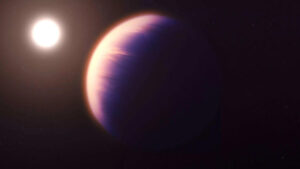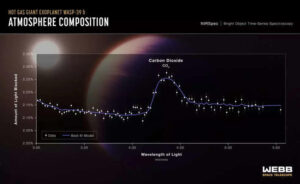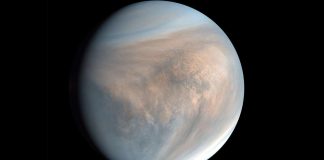AUGUST 25, 2022

- The James Webb Space Telescope detected clear evidence of carbon dioxide in an exoplanet’s atmosphere.
- The planet, WASP-39 b, is a hot gas giant orbiting a sun-like star about 700 light-years from Earth.
Astronomers using NASA’s James Webb Space Telescope have conclusively detected evidence of carbon dioxide in a world beyond our solar system.
The planet, called WASP-39 b, is a gas giant orbiting a sun-like star about 700 light-years away, where temperatures are consistently about 1,600 degrees Fahrenheit, or 900 degrees Celsius. While the planet was first discovered in 2011, Webb’s sensitive infrared instruments allowed researchers to analyze it in detail, definitely detecting carbon dioxide there for the first time.
To better understand exoplanets, or planets around other stars, researchers train their telescopes to measure the chemical makeup of the exoplanet’s atmospheres. They do this by looking at how starlight gets filtered by the atmosphere, which dips at very specific wavelengths that correspond to different molecules.
Using Webb’s NIRSpec instrument, astronomers looked at the gases and chemicals present in WASP-39 b’s atmosphere on July 10.
“As soon as the data appeared on my screen, the whopping carbon dioxide feature grabbed me,” said Zafar Rustamkulov, a planetary scientist and member of the transiting exoplanet team, in a press release. “It was a special moment, crossing an important threshold in exoplanet sciences.”

“Detecting such a clear signal of carbon dioxide on WASP-39 b bodes well for the detection of atmospheres on smaller, terrestrial-sized planets,” Natalie Batalha, an astronomer who leads the transiting exoplanet team, said in a press release.
While carbon dioxide is associated with life on Earth, astronomers typically look for the ingredients that sustain life — liquid water, a continuous source of energy, carbon, and other elements — when hunting for life in distant worlds.
When NASA revealed the first batch of Webb images on July 12, the agency included data showing the existence of water, along with evidence of clouds and haze, in the atmosphere of an exoplanet called WASP-96 b, which orbits a sun-like star.
More discoveries are almost inevitable as Webb’s capabilities allow for unprecedented views into the atmospheres of distant planets.
“With the James Webb Space Telescope, we can explore the chemical makeup of the atmosphere of other worlds — and if there are signs in it that we can only explain by life,” Lisa Kaltenegger, professor of astronomy at Cornell University and director of the Carl Sagan Institute, previously told Insider.
“It is an amazing time in our exploration of the cosmos,” Kaltenegger said, adding, “Are we alone? This amazing space telescope is the first-ever tool that collects enough light for us to start figuring this fundamental question out.”









































































































